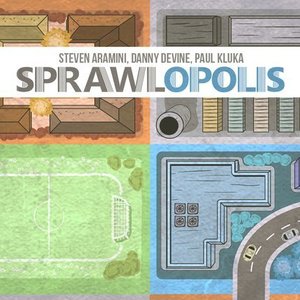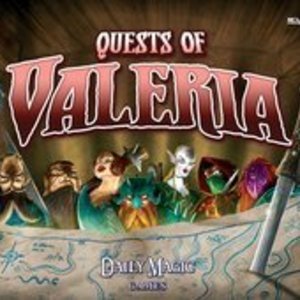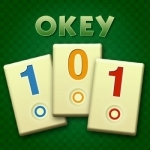Purple Phoenix Games (2266 KP) rated Sprawlopolis in Tabletop Games
Jun 12, 2019
If you had the chance to design a city, how would you do it? Would you have a park on every block for some nice greenery, or do you think a large commercial district will bring in more people? What about housing – would people live right in the heart of the city, or would they live more on the outskirts? The day has finally come where those decisions are up to you! Well, mostly. You’ve been hired to help design the ultimate city! The city officials have given you some specific requirements, but beyond that, the plans are up to you! Can you meet their needs while also maximizing your space? It’s time to put your skills to the test and build the best city ever!
Sprawlopolis is a cooperative card placement game of only 18 cards. Given 3 random scoring conditions, you must draw and play cards into the city to fulfill those requirements. Meet or exceed their score, and you win the game! Fail to do so, and you have not succeeded in building the city up to specifications. Be careful how you decide to place your cards, however, because depending on the scoring conditions in play, certain placements could result in negative points at the end of the game. Working together, you and your team must decide which cards to play at what time to ensure that the requirements are all met. Solo play is identical to cooperative play, except that you just always have a hand of 3 cards from which to play. The score to beat each game is dependent on the scoring conditions, so this game isn’t just another beat-your-own-high-score game – you actually have a specific number in mind.
For a game with only 18 cards, there is a lot of variability in Sprawlopolis. I have yet to play 2 identical games. The layout of each card is unique, as are all of the scoring conditions, so the possibilities are endless… almost! I also enjoy playing this game solo because it requires a decent amount of strategy. Three things factor into your final score (the scoring conditions, block groupings, and roads) and it is impossible to succeed by focusing on only one of them. Your strategy is always changing based on the cards in your hand, and you really have to think about how to best utilize each card for maximum end-game points. Depending on when and where you play a card, it could change the entire city so you have to be thinking about the big picture, literally! And a neat thing about Sprawlopolis is that you can overlap cards. So maybe a card you played earlier is not really ideal anymore, given your current hand, so you can just cover up either a portion of it or the entire card!
The hardest thing about Sprawlopolis for me is that certain combinations of scoring conditions can be difficult to complete. One may give you points for a certain type of city block, but then another may take away as many, or more, points for that same type of city block. Or one gives you points for certain roads, but all roads result in negative points during end-game scoring. Since the scoring conditions are chosen randomly, there’s not really a way to negate this unless you just re-draw those cards. You usually can’t just look at a scoring condition combination and know if it will be difficult or not either – you just have to try it. I’m not saying they’re impossible necessarily, just harder to successfully complete.
Overall, I think Sprawlopolis is a neat game. It’s fast and easy to learn, yet strategic enough to keep you coming back for more games. I like to use it as a nice light filler game between some bigger games, or I just like to play it if I’ve got a quick 15 minutes to spare! Sprawlopolis is a fun game to play with a group, and it’s also a fun game to play solo. In my arsenal of solo games, it’s definitely one on standby.
https://purplephoenixgames.wordpress.com/2019/02/11/solo-chronicles-sprawlopolis/
Purple Phoenix Games (2266 KP) rated Quests of Valeria in Tabletop Games
Jun 12, 2019
A royal King may rule the city of Valeria, but we all know who really is responsible for the prosperity of this kingdom – it’s YOU, the Guild Masters! Your hard work behind the scenes (providing work for Citizens, and overseeing the completion of various Quests) has helped turn Valeria into the thriving epicenter of life and commerce that it is today! Make sure you keep up the good work, because if you don’t, another Guild Master will jump at the opportunity to outperform you and win the favor of the King!
Quests of Valeria, a game of card drafting and hand management, pits players against each other as they try to hire Citizens to complete Quests and earn Victory Points. Each Quest requires certain Citizen roles and Resources to be completed, so strategy is key! Work efficiently, or another Guild Master could swipe a Citizen or Quest right out from under you! On your turn, you will take 2 actions from these listed: Draw, Hire, Reserve, or Quest. Citizen and Quest cards sometimes have special powers that, when played, allow you to take bonus actions on your turn. The game continues until a player has completed their 5th quest, and then all players count up their Victory Points. The player with the highest score is the winner! In solo play, the game ends when either the Citizen or Quest card deck is completely depleted – the solo player then counts up their Victory Points and tries to beat their personal best score!
As a solo game, Quests of Valeria is played almost exactly the same way, with one main gameplay difference. That difference has to do with the setup and handling of the available Citizen and Quest cards. In group play, Citizens and Quest cards remain in the game until their are either hired, completed, or actively discarded. In solo play, at the end of each turn, the Citizen and Quest cards at the furthest left side of the Tavern Line (play area, see photo below for reference) are discarded permanently from the game. All other cards shift one or more spaces as far left as possible in the Tavern Line and any remaining empty slots are refilled from their respective draw decks. This puts a time limit on how long cards remain in the game without being hired/completed. It really forces you to strategize which Citizens to hire and when since they only appear for a finite amount of time. The same goes for Quests – each turn pushes Quests closer to elimination from the game, so you must act quickly and efficiently to complete as many as you can before they are discarded.
I really like the idea of the shifting Tavern Line in solo play. The game would be so easy without it – there would be no rush to do anything and no real strategy involved since I could just bide my time until I have the appropriate Citizens to complete each Quest. With the shifting line, I do have to come up with an ever-changing strategy. I can’t just focus on one Quest – I have to be looking ahead to see what I need for the next quest and how long I have to complete that one too.
My only dislike of this game is that sometimes it can be slow-going getting your Guild up and running. Sometimes the Citizens and Resources I need just aren’t showing up in the Tavern Line (thanks to my awful card shuffling, I’m sure) and I just get to watch those Quests make their way through the line towards the discard pile. And then usually with my luck, I discard precious cards from my hand to Hire a Citizen that I was waiting for only to have all of those Quests slowly replaced by Quests for the Citizens that I was passing on! Since I can only have a maximum of 8 Citizens in my Guild at any given time, I can’t just recruit everybody until I get a Quest that needs those people. It’s a balancing act for sure, and it’s one that I haven’t quite mastered. I’m sure that once I figure out a better strategy for handling this type of situation, I’ll enjoy the game more. But for now, these stand-stills have me stumped.
Overall, I enjoy Quests of Valeria as a solo game. It requires a decent amount of strategy, and the more I play it, the more I like it. There’s no single strategy for success, and I like to try out different ones with each game – do I try to finish as many easy Quests as possible (fewer VPs each, but more Quests overall), or do I save up my Citizens and go only for the big Quests (lots of VPs, but also lots of required Citizens/Resources)? There’s not a right answer, and I enjoy being able to adapt my strategy to the cards currently in play. For such a simple game (Hire Citizens, complete Quests), Quest of Valeria keeps me engaged the entire time. It’s easy to learn, fast to play, and strategic enough that it keeps you hooked. Give it a try as a solo game – it might surprise you!
https://purplephoenixgames.wordpress.com/2019/03/28/solo-chronicles-quests-of-valeria/
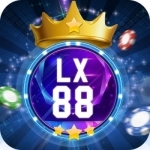
LX88 game bai, danh bai online
Games
App
LX88 – TAI GAME BAI, DANH BAI ONLINE 2018 ( TAI GAME BAI ONLINE, DANH BAI ONLINE 2018 ) la the...
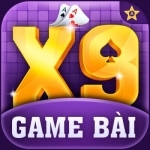
X9- Game Danh Bai Online
Games and Entertainment
App
X9 ONLINE - PHAT TAI QUA TUNG VAN BAI (Game bai, Game danh bai) - Hoi tu day du cac game bai hot...

Fang69 - Game Bai Online
Games and Entertainment
App
Fang69 là game đánh bài online khác biệt với tất cả các game khác ở những đặc ...
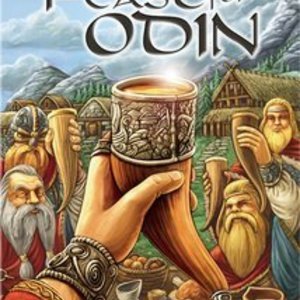
A Feast for Odin
Tabletop Game
Using the central board in A Feast for Odin, players have to hunt, gather basic materials, refine...
Boardgames UweGames

Potion Explosion
Games
App
The official adaptation of Potion Explosion, the award-winning puzzle board game. Play this game...

Tsuro - The Game of the Path
Entertainment and Games
App
A simple tile laying game where the goal is to stay alive the longest. Each tile you play moves your...
BoardGameApp
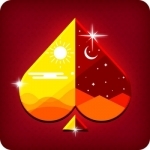
Daily Solitaire
Games and Stickers
App
Daily Solitaire: Poker Saga is a fantastic example of how to make a mobile solo card game that's...
